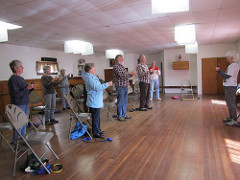
It is common practice for exercisers to take their heart rate after a bout of exercise. Whether running a track interval or performing an aerobics routine, this method is frequently used to monitor the intensity of exercise.
If you are part of an exercise group, common procedure is to wait until everyone has located their pulse (often 15 seconds or so) then to time six, 10 or 15 seconds while everyone counts their own heart beats. You then multiply by the appropriate number (10, 6 or 4, respectively) to arrive at a beats-per-minute value.
However, research has shown that this procedure underestimates heart rates because of the time-lag after the cessation of exercise. In fact, heart rates drop very quickly after exercise ends. This is particularly true for trained athletes.
MANUAL PULSE MEASUREMENT STUDY
A study at the University of Texas at Austin investigated manual heart rate measurement methods by comparing them to actual heart rates as measured by an ECG. The subjects performed exercise sessions at 70{3813292df256cc7359db914c8bfffc508a0964aa786224d36d2cb21f4b33d600} or 85{3813292df256cc7359db914c8bfffc508a0964aa786224d36d2cb21f4b33d600} of their max heart rate. They waited 15 seconds after the end of the session, then counted their pulse for 15 seconds and multiplied by four to get their beats-per-minute count.
At the same time, an ECG measured their actual heart rates at three different times: during the last 10 seconds of exercise; in the first 15 seconds after exercise; then 15 seconds after that.
The manual measurements and the ECG results were then compared.
FINDINGS
The study revealed several things:
1. Both ECG and manual measurements – if taken after the exercise ended – underestimated the heart rate reached during the final 10 seconds of the exercise session.
2. Even the ECG taken immediately after exercise, yielded a heart rate that was 7-9 beats per minute lower than the during-exercise rate. This is because heart rates drop dramatically once exercise ends – especially for trained athletes.
3. The longer the wait before taking a pulse, the less accurate the measurement.
4. Manual methods for measuring pulse rates were fairly accurate, although the radial (wrist) method was less accurate at higher heart rates than the cartotid (neck) method. The radial method yielded results that were too low by about 10 beats per minute.
CONCLUSIONS
1. The best way to measure exercise heart rate is by measuring it during exercise. Using a heart rate monitor is best.
2. You can measure manually, post-exercise, as long as you add a correction factor (see below). Measuring at the carotid pulse is generally most accurate, as long as you do not press too hard, which can stimulate the carotid sinus reflex and lower the heart rate.
3. The sooner you can take the measurement, the more accurate it will be.
4. A six-second or 10-second measuring period will probably be more accurate than a 15-second period because they give the heart less time to recover.
CORRECTION FACTOR IF COUNTING PULSE RATES AFTER EXERCISE
If heart rate is measured after exercise, either manually or with a heart rate monitor:
1. Add 10 beats per minute if measured within 10 seconds.
2. Add 20 beats per minute if measured after 15 seconds.
These are ballpark numbers, but you cannot expect field measurements to be exact. To get a practical read on levels of exertion, it is best to combine heart rate estimates with your own feedback on perceived exertion.
Reference: Allison DeVan, Barbara Lacy, Miriam Cortez-Cooper, Hirofumi Tanaka, Post-exercise palpation of pulse rates: its applicability to habitual exercisers Scandinavian Journal of Medicine & Science in Sports, 15:177-181, 2005.
Related Exercise Articles
You must be logged in to post a comment